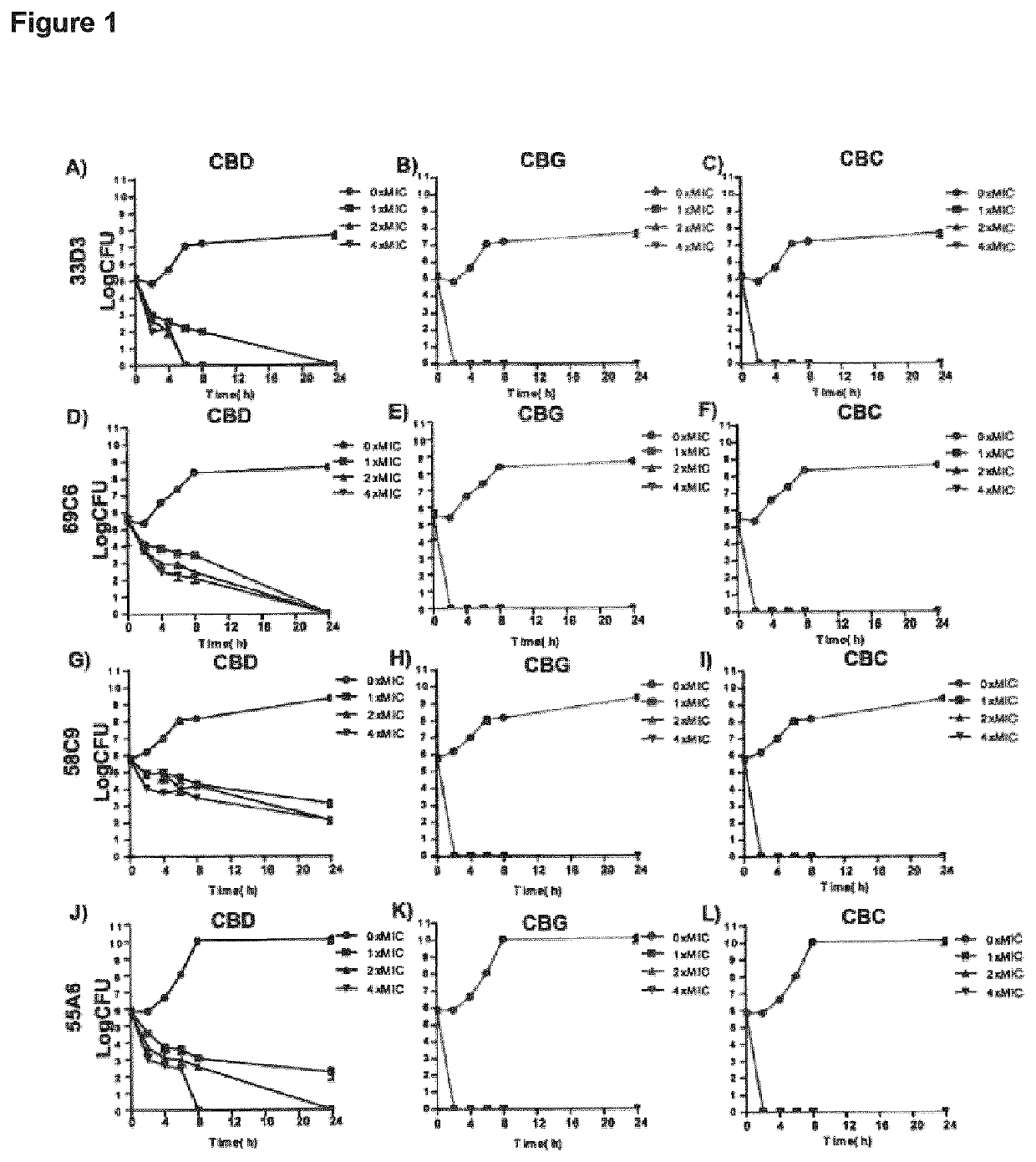Antibiotic cannabinoid-terpene formulations
a technology of cannabinoid terpene and formulation, applied in the field of medicinal preparations, can solve the problems of opportunistic infection, increased difficulty in treating enterococcal infections, and known as a leading cause of dangerous infections
- Summary
- Abstract
- Description
- Claims
- Application Information
AI Technical Summary
Benefits of technology
Problems solved by technology
Method used
Image
Examples
example 1
[0051]As illustrated in this Example, the non-psychotropic cannabinoids, cannabidiol, cannabigerol and cannabichromene (i.e., CBD, CBG, and CBC), have bacteriostatic (Tables 1, 2) and bactericidal (FIG. 1) activities against E. faecium and E. faecalis, including strains that are sensitive or resistant to vancomycin and, in some cases, also resistant to daptomycin. At equal concentrations of CBD, CBG, or CBC, the kinetics of E. faecium killing with CBG and CBC are faster than for CBD (FIG. 1). It is further shown that cannabinoids can also increase the activity of daptomycin (MIC) by 8-128 fold (Table 3). In addition, we demonstrate that each cannabinoid has species specific activities against Gram positive (but not Gram negative) bacteria (Table 1).
[0052]As further illustrated in this Example, the non-psychotropic cannabinoids, cannabidiol, cannabigerol and cannabichromene (i.e., CBD, CBG, and CBC), trans-caryophyllene, and daptomycin act in synergy. Assays for interactions between ...
example 2
id Sensitization to Daptomycin
[0082]As illustrated in FIG. 2, cannabinoids sensitize antibiotic resistant Enterococcal strains to daptomycin. FIG. 2 reflects data illustrating the effects of daptomycin (Dap), and Dap in combination with CBD, CBG or CBC, on daptomycin resistant E. faecium VRE strains 58C9 and 55A6. E. faecium strain 55A6 is resistant to daptomycin with a daptomycin MIC=8 mg / L. E. faecium strains 58C9 and 55A6 were incubated with no cannabinoid (A,B), or ½x (0.5 mg / L) MIC of CBD (C,D), CBG (E,F) or CBC (G, H) with 1x (4 mg / L for 58C9; 8 mg / L for 55A6), ½x (2 mg / L for 58C9; 4 mg / L for 55A6), ¼x (1 mg / L for 58C9; 2 mg / L for 55A6) or ⅛x (0.5 mg / L for 58C9; 1 mg / L for 55A6) MIC of daptomycin. Aliquots were removed at 2, 4, 6, 8 and 24 h for CFU enumeration. Data points are the means from three replicates with standard deviations presented as error bars. As illustrated, adding approximately ½ MIC of each cannabinoid facilitated killing by daptomycin at ¼-⅛x the MIC of dapt...
example 3
BG Biofilm Inhibition
[0085]This example illustrates that CBD and CBG are surprisingly effective at inhibiting E. faecium biofilm growth. The data in FIG. 4 was generated by growing biofilms of E. faecium strain 33D3 for 48 h without cannabinoids, then treating the biofilms with cannabinoids for 72 h. The mass of the biofilm was quantitated by crystal violet staining. Viable bacteria in the biofilm were quantitated by scrapping biofilm then counting the viable bacteria. As illustrated, CBD and CBG illustrate a surprising degree of antibiotic activity against the strain 33D3 of E. faecium. Of note, CBC was bactericidal against planktonic Enterococci.
PUM
| Property | Measurement | Unit |
|---|---|---|
| concentrations | aaaaa | aaaaa |
| concentrations | aaaaa | aaaaa |
| concentrations | aaaaa | aaaaa |
Abstract
Description
Claims
Application Information
 Login to View More
Login to View More - R&D
- Intellectual Property
- Life Sciences
- Materials
- Tech Scout
- Unparalleled Data Quality
- Higher Quality Content
- 60% Fewer Hallucinations
Browse by: Latest US Patents, China's latest patents, Technical Efficacy Thesaurus, Application Domain, Technology Topic, Popular Technical Reports.
© 2025 PatSnap. All rights reserved.Legal|Privacy policy|Modern Slavery Act Transparency Statement|Sitemap|About US| Contact US: help@patsnap.com



